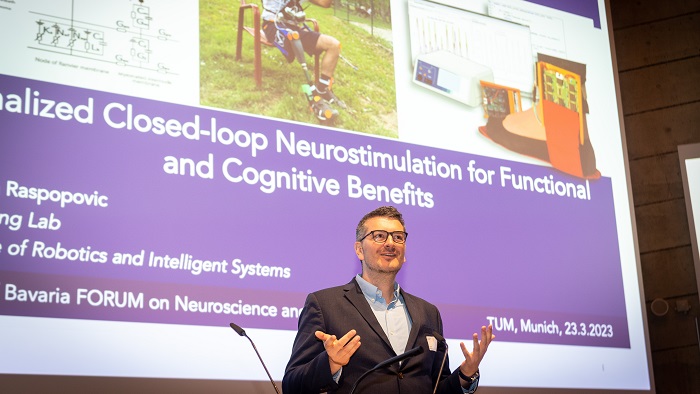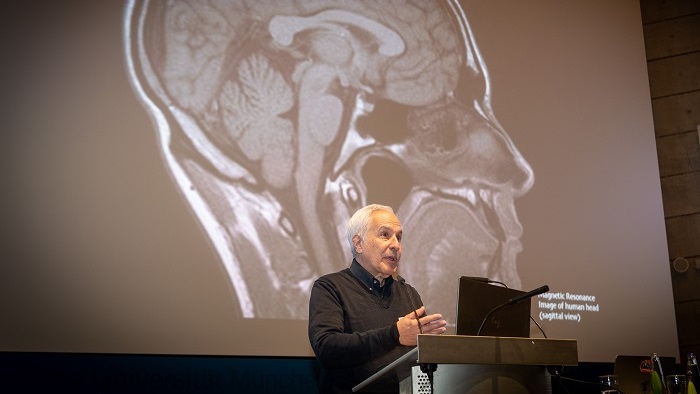Elite Network of Bavaria FORUM Focuses on Neurosciences
Under the title "From Connectomes to Brain Computer Interfaces", the Elite Network continued its Bavaria-wide visible event series "FORUM" after a pandemic-related break on 23 March 2023 in the Audimax of the Technical University of Munich (TUM).
Two Elite Graduate Programs, "Biomedical Neurosciene" and "Neuroengineering" at TUM, had joined forces an organized the event together. More than 300 registrations confirm the high social and scientific relevance of neuroscience itself as well as its potential for applications such as neuroprosthetics in engineering. With Prof. Jeff Lichtmann (Harvard University) and Prof. Stanisa Raspopovic (ETH Zurich), two distinguished speakers could be won, who conveyed the impressive progress of the last years as well as the current and future challenges to an interested expert audience. Beate Linder (Elite Network of Bavaria) and Prof. Juliane Winkelmann (Vice President International Alliances and Alumni, TUM) welcomed the guests and students in the TUM Audimax.
Jeff Lichtman, professor of molecular and cellular biology at Harvard University, provided fascinating insights into the structure of the brain at the cellular level. At the end of the 19th century, Ramon y Cajal and Camillo Golgi were successful in showing that neurons, special brain cells, form an interrelated network of interconnected cells. The relatively young research field Connectomic, in the creation of which Jeff Lichtman was significantly involved, deals with the construction of the neuronal network, with the goal of creating a complete three-dimensional "map" of the brain. Using a special technique (Automatic Tape-Collecting Lathe Ultramicrotome), Jeff Lichtman's research group is able to obtain ultrathin two-dimensional sections of small brain samples and visualize the cellular and subcellular structures under the electron microscope. With great computational effort, computers can then generate a three-dimensional image from these two-dimensional maps. So far, it has been possible to "map" brain areas in the size of a thousandth of a milliliter. In the process, it became apparent in spectacular resolution how complex our neuronal network itself is structured in detail. Jeff Lichtman's lecture and pictures left a tangible impression and fascination on our young scientists, which led to many lively discussions afterwards.

Stanisa Raspopovic, Assistant Professor of Neuroengineering at the Department of Health Sciences and Technology at ETH Zurich, combines physiological and clinical expertise on the brain and the nervous system. He demonstrates how a combination with hardware, physics, and software tools can improve the quality of life of e.g. patients with neurological restrictions. The decisive tool for this is computer-aided modeling of the interaction of the nervous system with electric fields. Together with his research group at ETH Zurich, Prof. Raspopovic develops, among other projects, mechatronic systems that form a direct interface between the environment and the rest of the nervous system, so-called brain-computer interfaces. As with all communication, this requires coding, a kind of "neural language". A major challenge here is the combination of a digital world of sensors and electrodes with the nervous system. In his presentation, Stanisa Raspopovic placed a special emphasis on patients with amputated lower limbs. In this context, sensors on the patient's prosthetic leg enable the patient to perceive ground contact and thus to walk significantly better. At the same time, such prostheses with neurointerface also reduce the otherwise common phantom pain.
An unforgettable evening
Both presentations demonstrated how neuroscience fundamentals are intertwined with applied research and development. The two impressive lectures led to a lively exchange between the students and lecturers of both courses, representatives of the scientific community and the two award winners. The poster exhibition, curated by students from both Elite Graduate Programs, was of particular interest to the guests. The Elite Network of Bavaria FORUM came to a beautiful end, musically framed by the jazz band "Thursday Chill out Combo" around Andreas Kurz, also (musical) award winner and lecturer at the University of Music and Theatre Munich.
The joint invitation of two Elite Programms has visibly increased the reach of the FORUM format. The feedback from the guests validates the format and clearly speaks for a continuation of the event series.
Text: Michael Brunnhuber, Pia Eckert und Florian Rattei, TUM


